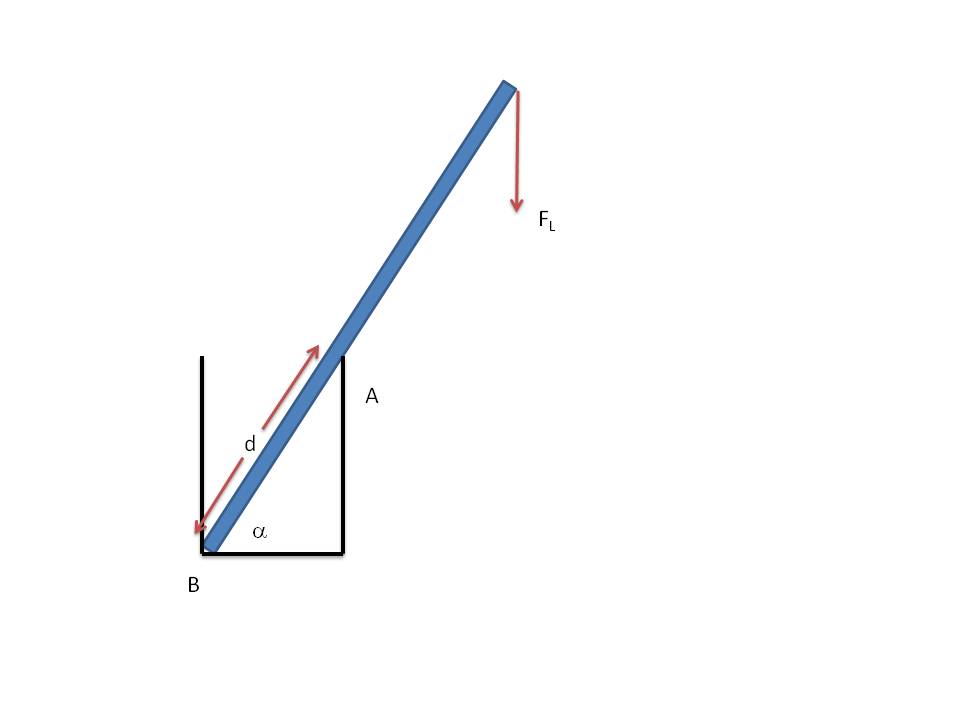
|
a. 70.26 N |
||
|
b. 66.22 N |
||
|
c. 23.47 N |
||
|
d. 50 N |
||
|
e. 93.47 N |

|
a. 70.26 N |
||
|
b. 110.37 N |
||
|
c. 23.47 N |
||
|
d. 50.00 N |
||
|
e. 66.22 N |

|
a. 50.00 N |
||
|
b. 110.367 N |
||
|
c. 70.26 N |
||
|
d. 66.22 N |
||
|
e. 66.64 N |
Which of the following units are appropriate for expressing pressure?
|
a. N/m2 |
||
|
b. N/m |
||
|
c. lbm |
||
|
d. N/s |
||
|
e. lbf/s |
Convert a pressure of 2 atmospheres to units of millimeters of water (at the earth’s surface). Which of the following best corresponds to that result?
|
a. 67.8 |
||
|
b. 32.4 |
||
|
c. 20664 |
||
|
d. 101325 |
||
|
e. 202650 |
1 furlong = 1/8 mile
1 fortnight = 2 weeks
|
a. 50 |
||
|
b. 38 |
||
|
c. 72 |
||
|
d. 19 |
||
|
e. 12 |
Which of the following is true for two vectors for which the dot product is zero?
|
a. They are perpendicular (orthogonal). |
||
|
b. They are parallel. |
||
|
c. They are coplanar. |
||
|
d. They form a 45 degree angle with respect to one another. |
||
|
e. They are antiparallel. |
Calculate the dot product of y = 2 i + 4 j + 8 k and z = 6 i + 4 j + 2 k. Which of the following matches the result?
|
a. 12 |
||
|
b. 16 |
||
|
c. 72 |
||
|
d. 38 |
||
|
e. 44 |
Calculate the cross product of y = 2 i + 4 j + 8 k and z = 6 i + 4 j + 2 k.Which of the following best matches the result?
|
a. 28 i + 12 j + 8 k |
||
|
b. 8 i + 48 j + 8 k |
||
|
c. -32 i + -4 j -24 k |
||
|
d. 2 i -12 j + 8 k |
||
|
e. -24 i + 44 j -16 k |
Find the angle between the two vectors y = 2 i + 4 j + 8 k and z = 6 i + 4 j + 2 k in degrees. Which of the following best matches the result?
|
a. 55 degrees |
||
|
b. 50 degrees |
||
|
c. 70 degrees |
||
|
d. 32 degrees |
||
|
e. 5 degrees |
A projectile is launched at an angle of 60 degrees from the horizontal at a speed of 1275 feet per second. What is the horizontal component of the projectile velocity in feet per second?
|
a. 425 ft/sec |
||
|
b. 638 ft/sec |
||
|
c. 736 ft/sec |
||
|
d. 1275 ft/sec |
||
|
e. 901 ft/sec |
|
a. 12 N and 7 N |
||
|
b. 10 N and 6 N |
||
|
c. 9 N and 14 N |
||
|
d. 15 N and 12 N |
||
|
e. 7 N and 8 N |
|
a. 5 N |
||
|
b. 10 N |
||
|
c. 20 N |
||
|
d. 25 N |
||
|
e. 30 N |
|
a. 866 N |
||
|
b. 423 N |
||
|
c. 978 N |
||
|
d. 1232 N |
||
|
e. 823 N |
In the figure below, the angle alpha is 18 degrees. The block B has a mass of 10 kg and is subject to a gravitational acceleration of 9.8 m2/s straight down. Block A is being held in place by external forces.
If the coefficient of static friction is 0.05, then what is the horizontal force required to start block B moving to the left?
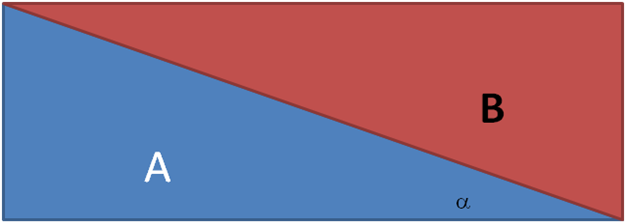
|
a. 34.9 N |
||
|
b. 4.7 N |
||
|
c. 30.3 N |
||
|
d. 37.3 N |
||
|
e. 42.8 N |
In the figure below, the angle alpha is 33 degrees. The block B has a mass of 10 kg and is subject to a gravitational acceleration of 9.8 m2/s straight down. Block A is being held in place by external forces.
If the coefficient of static friction is 0.05, then what is the horizontal force required to start block B moving to the left?

|
a. 70.8 N |
||
|
b. 30.7 N |
||
|
c. 37.4 N |
||
|
d. 0.57 N |
||
|
e. 98 N |
If the coefficient of static friction is 0.07, then what is the horizontal force required to start block B moving to the left?

|
a. 70.8 N |
||
|
b. 73.9 N |
||
|
c. 75.8 N |
||
|
d. 33.7 N |
||
|
e. 98 N |
As illustrated in the figure below, block B resides on an incline. The static coefficient of friction between the block and the incline is 0.343. At what value of the inclination (in degrees) will the block begin to slide under the influence of vertical gravitational acceleration?
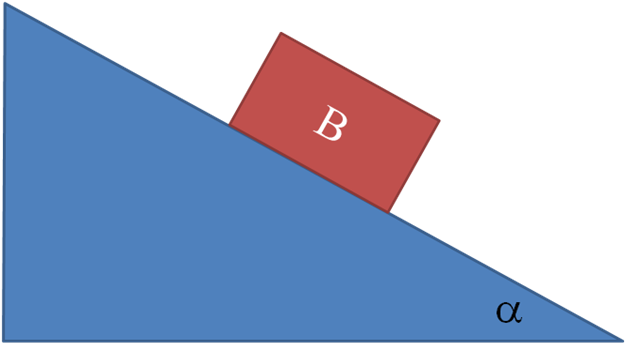
|
a. 21 degrees |
||
|
b. 2 degrees |
||
|
c. 19 degees |
||
|
d. 32 degrees |
||
|
e. 26 degrees |
As illustrated in the figure below, block B resides on an incline. The static coefficient of friction between the block and the incline is 0.38. At what value of the inclination (in degrees) will the block begin to slide under the influence of vertical gravitational acceleration?

|
a. 21 degrees |
||
|
b. 2 degrees |
||
|
c. 7 degees |
||
|
d. 32 degrees |
||
|
e. 26 degrees |
In the schematic below, the block B has a mass of 25 kg. The coefficient of static friction between the block and the ramp is 0.42. The angle alpha is 0.19 radians. What is the magnitude of the force FR required to keep the block from sliding under the influence of a vertical gravitational acceleration of 9.8 m2/s?
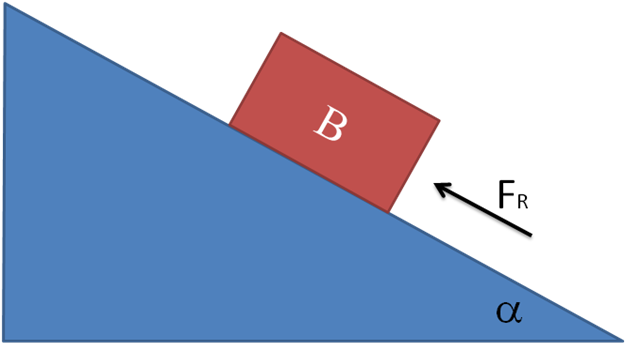
|
a. 42 N |
||
|
b. 12 N |
||
|
c. 245 N |
||
|
d. 246 N |
||
|
e. 46 N |
In the schematic below, the block B has a mass of 18 kg. The coefficient of static friction between the block and the ramp is 0.42. The angle alpha is 0.25 radians. What is the magnitude of the force FR required to keep the block from sliding under the influence of a vertical gravitational acceleration of 9.8 m2/s?

|
a. 61 N |
||
|
b. 44 N |
||
|
c. 245 N |
||
|
d. 246 N |
||
|
e. 46 N |
In the schematic below, the block B has a mass of 25 kg. The coefficient of static friction between the block and the ramp is 0.42. The angle alpha is 0.25 radians. What is the magnitude of the force FR required to keep the block from sliding under the influence of a vertical gravitational acceleration of 9.8 m2/s?

|
a. 61 N |
||
|
b. 44 N |
||
|
c. 245 N |
||
|
d. 246 N |
||
|
e. 46 N |
As illustrated in the figure below, block B resides on an incline. The static coefficient of friction between the block and the incline is 0.488. At what value of the inclination (in degrees) will the block begin to slide under the influence of vertical gravitational acceleration?

|
a. 21 degrees |
||
|
b. 2 degrees |
||
|
c. 19 degees |
||
|
d. 32 degrees |
||
|
e. 26 degrees |
|
a. 2.2 |
||
|
b. 0.62 |
||
|
c. 4.1 |
||
|
d. 4023 |
||
|
e. 1x1035 |
|
a. 4.4 |
||
|
b. 2.6 |
||
|
c. 1.5 x 1035 |
||
|
d. 0.57 |
||
|
e. 7.1 |
|
a. 200 N |
||
|
b. 300 N |
||
|
c. 880 N |
||
|
d. 600 N |
||
|
e. 500 N |
|
a. 5 N |
||
|
b. 40 N |
||
|
c. 50 N |
||
|
d. 60 N |
||
|
e. 30 N |
In the diagram below, the angle alpha is 60 degrees and the angle beta is 150 degrees. Which of the following statements must be true in order for the particle at the center to not accelerate under the influence of forces F1, F2, and F3?
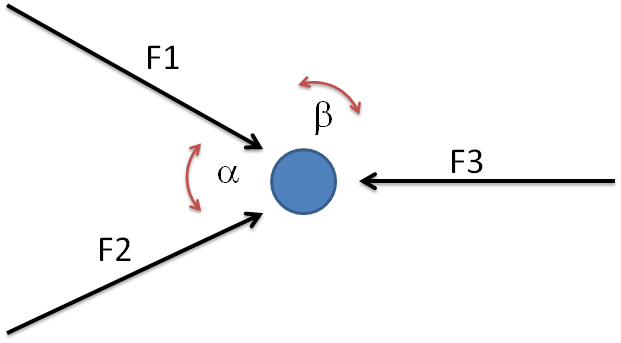
|
a. F1, F2, and F3 must all be of equal magnitude. |
||
|
b. All forces must be zero. |
||
|
c. F1 and F2 must have equal magnitude. The magnitude of F3 must be 2 cos(30 degrees) |F2|. |
||
|
d. F1 and F2 must have equal magnitude. The magnitude of F3 must be 2 cos(60 degrees) |F2|. |
||
|
e. F1 and F2 must have equal magnitude. The magnitude of F3 must be 2 sin(30 degrees) |F2|. |
Consider a rope 5 m long running from points A to B as in the figure below. The two walls are only 3 m apart; therefore, the rope sags. The difference in elevation of points A and B is 1 m. Along the rope, a frictionless pulley suspends a load of 200 N. Calculate the tension in the rope at equilibrium.
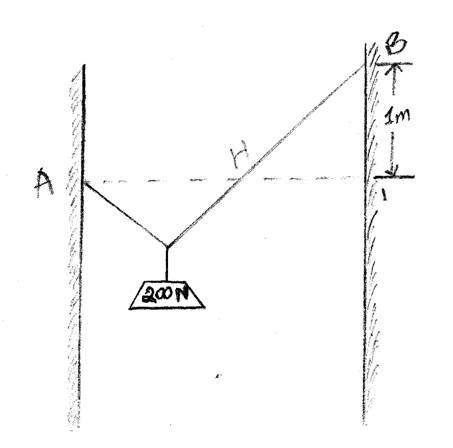
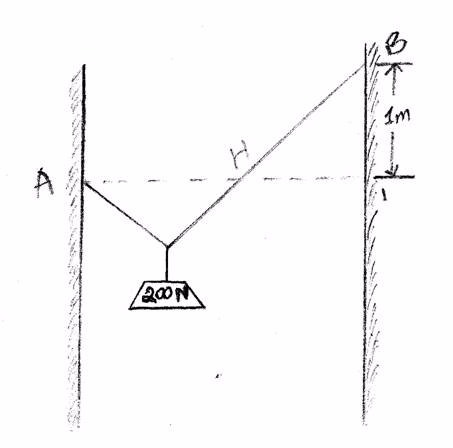
|
a. 125 N |
||
|
b. 250 N |
||
|
c. 175 N |
||
|
d. 75 N |
||
|
e. 50 N |
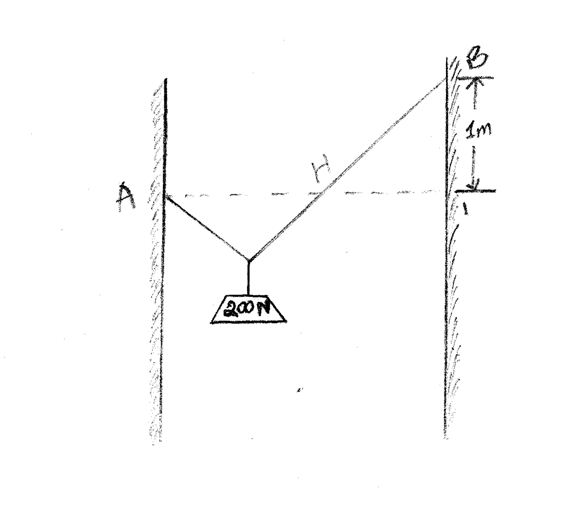
|
a. 0.55 m |
||
|
b. 1.25 m |
||
|
c. 1.125 m |
||
|
d. 2.25 m |
||
|
e. 0.33 m |

|
a. 0.55 m |
||
|
b. 1.25 m |
||
|
c. 1.125 m |
||
|
d. 2.25 m |
||
|
e. 1.5 m |
In the diagram below, the angle alpha is 50 degrees and the angle beta is 155 degrees. Which of the following statements must be true in order for the particle at the center to not accelerate under the influence of forces F1, F2, and F3?

|
a. F1, F2, and F3 must all be of equal magnitude. |
||
|
b. All forces must be zero. |
||
|
c. F1 and F2 must have equal magnitude. The magnitude of F3 must be 2 cos(25 degrees) |F2|. |
||
|
d. F1 and F2 must have equal magnitude. The magnitude of F3 must be 2 cos(60 degrees) |F2|. |
||
|
e. F1 and F2 must have equal magnitude. The magnitude of F3 must be 2 sin(30 degrees) |F2|. |
In the diagram below, the angle alpha is 120 degrees and the angle beta is 120 degrees. Which of the following statements must be true in order for the particle at the center to not accelerate under the influence of forces F1, F2, and F3?

|
a. F1, F2, and F3 must all be of equal magnitude. |
||
|
b. All forces must be zero. |
||
|
c. F1 and F2 must have equal magnitude. The magnitude of F3 must be 2 cos(30 degrees) |F2|. |
||
|
d. F1 and F2 must have equal magnitude. The magnitude of F3 must be 2 sin(30 degrees) |F2|. |
||
|
e. F1 and F2 must have equal magnitude. The magnitude of F3 must be 2 sin(45 degrees) |F2|. |
|
a. 4.4 |
||
|
b. 2.6 |
||
|
c. 1.5 x 1035 |
||
|
d. 0.57 |
||
|
e. 3.3 |
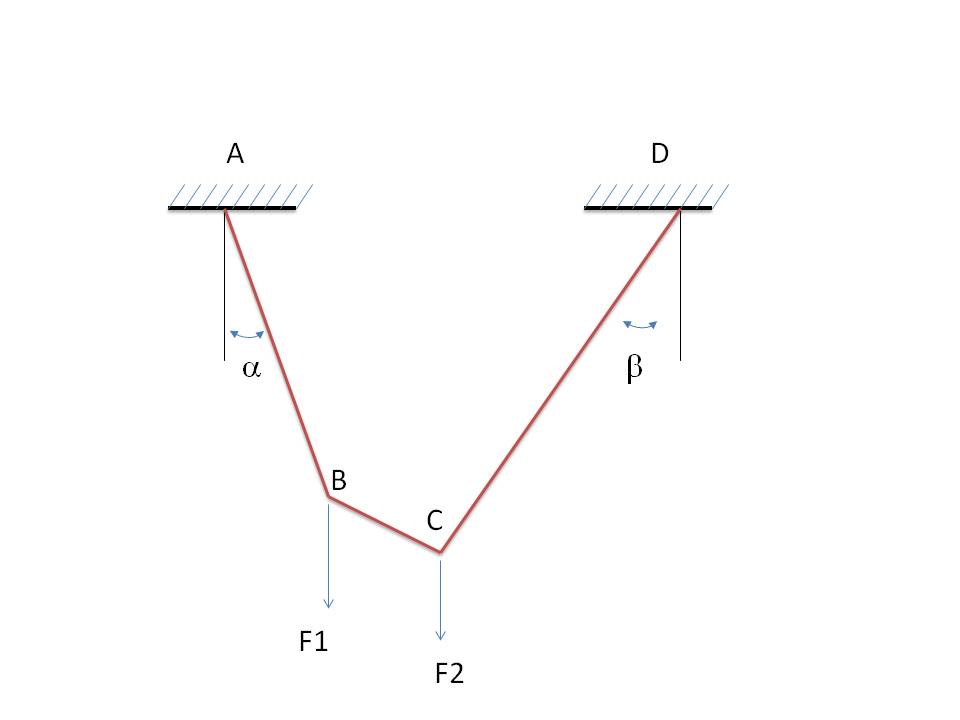
|
a. 190 kN |
||
|
b. 225 kN |
||
|
c. 427 kN |
||
|
d. 390 kN |
||
|
e. 475 kN |

|
a. 190 kN |
||
|
b. 225 kN |
||
|
c. 427 kN |
||
|
d. 390 kN |
||
|
e. 475 kN |

|
a. 190 kN |
||
|
b. 225 kN |
||
|
c. 238 kN |
||
|
d. 390 kN |
||
|
e. 475 kN |
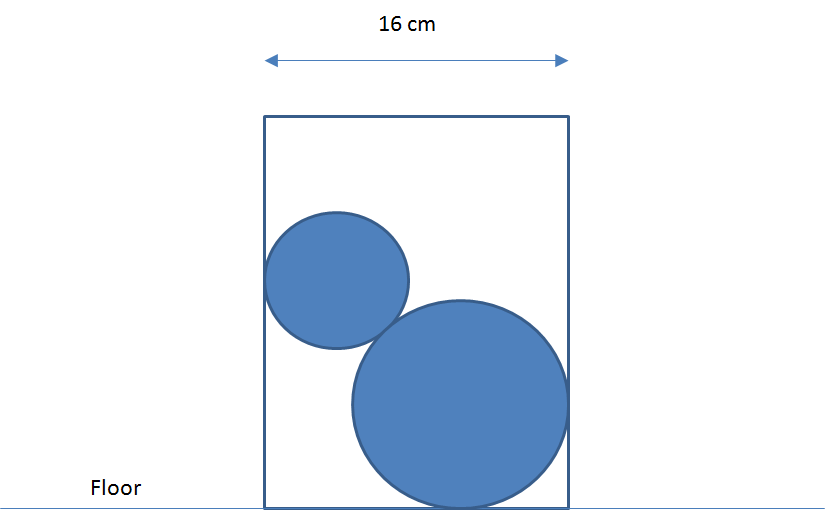
|
a. 7.5 N |
||
|
b. 15 N |
||
|
c. 3.5 N |
||
|
d. 8.5 N |
||
|
e. 12 N |
Which of the following formulas correctly describes the area moment of inertia for an object with elements a distance r from the axis of interest and with local mass density m?
|
a. ∫ r 2 dA |
||
|
b. ∫ r 3 dA |
||
|
c. ∫ m r 2 dA |
||
|
d. ∫ r m 2 dA |
||
|
e. ∫ mr 4 dA |
Which of the following is an appropriate unit for an area moment of inertia?
|
a. L 4 |
||
|
b. M L 4 |
||
|
c. L 2 |
||
|
d. M 2 L 2 |
||
|
e. M 2 L 3 |
Which of the following correctly relates the polar area moment of inertia (J0) to Ix and Iy?
|
a. J0 = Ix + Iy |
||
|
b. J0 = Ix 2 + Iy 2 |
||
|
c. J0 = sqrt (Ix 2 + Iy 2 ) |
||
|
d. J0 = 1/2 Ix 2 + 1/2 Iy 2 |
||
|
e. J0 = 1/2 Ix + 1/2 Iy |
In the figure below, if a = 1 m, b = 2 m, c = 3 m, and d = 1 m, then what is the area moment inertia of the shape about the x-axis?
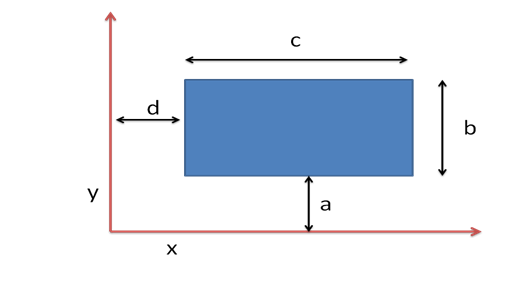
|
a. 26/3 m 4 |
||
|
b. 8/3 m 4 |
||
|
c. 6/3 m 4 |
||
|
d. 6/3 m 2 |
||
|
e. 4 m 3 |
In the figure below, if a = 1 m, b = 2 m, c = 3 m, and d = 1 m, then what is the area moment inertia of the shape about the y-axis?

|
a. 63/3 m 4 |
||
|
b. 5 m 4 |
||
|
c. 5 m 3 |
||
|
d. 4 m 2 |
||
|
e. 16/3 m 2 |
|
a. 33 1/3 m 4 |
||
|
b. 7 m 4 |
||
|
c. 3 m 2 |
||
|
d. 8 m 2 |
||
|
e. 89/3 m 4 |
Which of the following formulas correctly expresses the mass moment of inertia I for a specimen of mass density rho, mass m, and volume V? Here, l is the distance of a volume element dV from the axis of rotation.
|
a. I = ∫v l 2 ρ dV |
||
|
b. I = ∫v m ρ dV |
||
|
c. I = ∫v m 2 ρ dV |
||
|
d. I = ∫v l 2 ρ/m dV |
||
|
e. I = ∫v m/V ρ dV |
Which of the following formulas correctly expresses the relationship between the mass moment of inertia I and the radius of gyration k for an object of mass m?
|
a. I = m k 2 |
||
|
b. I = m k 0 |
||
|
c. I = m k -2 |
||
|
d. I = m k m |
||
|
e. I = m k 1 |
Which of the following is consistent with the parallel axis theorem for the mass moment of inertia?
I. The mass moment of inertia of an object about an axis through the center of mass is smaller than that about any other axis in the same direction.
II. The mass moments of inertia of an object about any parallel axes are identical.
III. The mass moment of inertia of an object about an axis (a) is equal to the moment about an axis (b) through the center of mass plus the mass times the square of the distance from (a) to (b).
IV. The mass moment inertia about parallel axes is proportional to the square of the separation between axes.
|
a. II only |
||
|
b. I and III only |
||
|
c. IV only |
||
|
d. III only |
||
|
e. III and IV only |
The box below extends from x= e to x = e + a, from y = f to y=f+c, and from z = d to z = d+b and has a uniform density rho (kg/m3). What is the mass moment inertia of the box about the y axis?
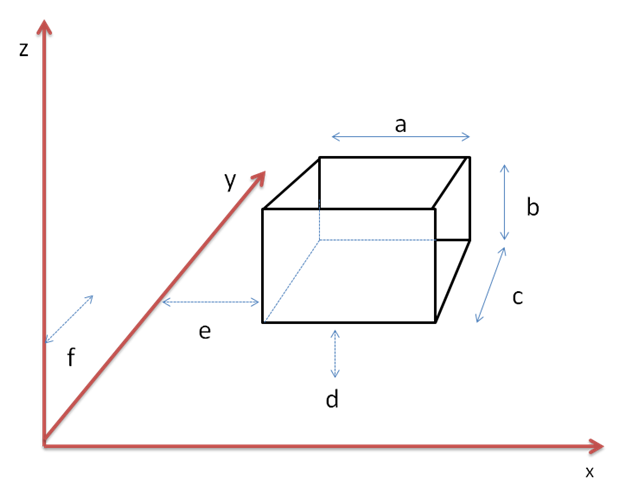
|
a. ((c+a)3 - a3)/3 ρ bc |
||
|
b. ((e+a)3 - a3)/3 ρ ac |
||
|
c. ((e+a)3 - a3)/3 ρ bc |
||
|
d. ((e+a)3 - a3)/3 ρ bc3 |
||
|
e. ((e+a)3 - a3)/ ρ bc |
The box below extends from x= e to x = e + a, from y = f to y=f+c, and from z = d to z = d+b and has a uniform density rho (kg/m3). What is the mass moment inertia of the box about the x axis?
|
a. ((f+c)3 - f3 )/3 ab ρ |
||
|
b. ((f+d)3 - f3 )/3 ab ρ |
||
|
c. ((e+c)3 - e3 )/3 ab ρ |
||
|
d. abc ρ |
||
|
e. bd ρ |
The box below extends from x= e to x = e + a, from y = f to y=f+c, and from z = d to z = d+b and has a uniform density rho (kg/m3). What is the mass moment inertia of the box about the z axis?

|
a. ((d+b)2 -d2) ac ρ/2 |
||
|
b. ((d+b)3 -d3) ab ρ |
||
|
c. ((d+b)3 -d3) ac ρ |
||
|
d. ((d+b)3 -d3) ac ρ/3 |
||
|
e. ((d+b)3 -d3) ac ρ/9 |
|
a. M T L |
||
|
b. M L 3 |
||
|
c. M L 2 |
||
|
d. L 4 |
||
|
e. M/L |
|
a. An elastic material gradually deforms under load and rebounds instantaneously when the load is removed. |
||
|
b. An elastic material deforms instantaneously and reversibly to changes in load. |
||
|
c. An elastic material deforms instantaneously under a load and gradually rebounds when the load is removed. |
||
|
d. An elastic material absorbs heat when stretched. |
||
|
e. An elastic material stretches under load but fractures at some critical load. |
How is the axial tensile strength of a cylindrical member related to the diameter of the member?
|
a. It increases linearly with diameter. |
||
|
b. It increases in proportion to the cube of the diameter. |
||
|
c. It is independent of diameter. |
||
|
d. It increases approximately as the square of the diameter. |
||
|
e. It increases approximately as the square root of the diameter. |
Which of the following correctly describes stress in the sense used in mechanics?
|
a. It is the vector sum of all forces acting on a system. |
||
|
b. It is the sum of all torques acting on a system. |
||
|
c. It is the square of the magnitude of the total force acting on a system. |
||
|
d. It is a loading force per unit area. |
||
|
e. It is a force per unit volume. |
A rod is being used to carry a tensile load of 5000 N. The ultimate tensile stress of the material used in the rod is 1000 MPa. What should be the absolute minimum diameter of the rod to safely carry the load?
|
a. 5 mm |
||
|
b. 10 mm |
||
|
c. 2.5 mm |
||
|
d. 50 mm |
||
|
e. 0.5 mm |
|
a. 20 mm |
||
|
b. 25 mm |
||
|
c. 50 mm |
||
|
d. 7.5 mm |
||
|
e. 2 mm |
A cylindrical rod is hung in a gravitational acceleration of 9.8 m/s2. The ultimate tensile stress of the rod material is 1800 MPa. The density of the rod material is 4000 kg/m3. How long may we make the rod before it fails under its own weight?
|
a. 1000 ft |
||
|
b. 52 miles |
||
|
c. 46 km |
||
|
d. 3 km |
||
|
e. 1.2 km |
A cylindrical rod is hung in a gravitational acceleration of 9.8 m/s2. The ultimate tensile stress of the rod material is 1800 MPa. The density of the rod material is 1000 kg/m3. How long may we make the rod before it fails under its own weight?
|
a. 46 km |
||
|
b. 12 km |
||
|
c. 184 km |
||
|
d. 1.8 km |
||
|
e. 0.2 km |
Which of the following is an appropriate unit for stiffness?
|
a. lbf |
||
|
b. lbf / ft |
||
|
c. kg/m |
||
|
d. psi/ft |
||
|
e. lbm/s |
|
a. kspi |
||
|
b. torr/ft |
||
|
c. Pa s |
||
|
d. N m |
||
|
e. N/yard |
A member of square cross section (10 mm on each side) and of 20 cm in length is subject to atensile load of 1 kN. The Young’s modulus of the material composing the member is 250 GPa.What is the extension of the member under load in mm?
|
a. 12 mm |
||
|
b. 14 mm |
||
|
c. 80 mm |
||
|
d. 0.2 mm |
||
|
e. 8 mm |
A member of square cross section (15 mm on each side) and of 20 cm in length is subject to a tensile load of 1 kN. The Young’s modulus of the material composing the member is 250 GPa.What is the extension of the member under load?
|
a. 0.53 inches |
||
|
b. 0.35 inches |
||
|
c. 3.6 mm |
||
|
d. 5 cm |
||
|
e. 22 mm |
Which of the following statements most closely describes Hooke’s law?
|
a. Extension is proportional to tension. |
||
|
b. Extension varies as the square root of tension. |
||
|
c. Extension varies as the square of tension. |
||
|
d. Extension reaches a maximum after which fracture occurs. |
||
|
e. Fracturing is a gradual process that occurs in proportion to extension. |
Which of the following statements correctly describes the properties of metallic, ionic, and covalently bonded materials?
I. Bonding electrons in covalent materials are localized to specific small sets of atoms.
II. Electrons in ionic materials are localized to one atom.
III. Covalent materials are more brittle than ionic materials.
IV. Metallic materials share a pool of delocalized electrons.
V. Metallic materials do not share electrons between atoms.
|
a. I and II |
||
|
b. I, II, and IV |
||
|
c. II, III, and V |
||
|
d. III and V |
||
|
e. V only |
The following curve is recorded in a tensile stress test for a rod of length 3 cm and diameter 10 mm. What is the ultimate tensile stress of the material?
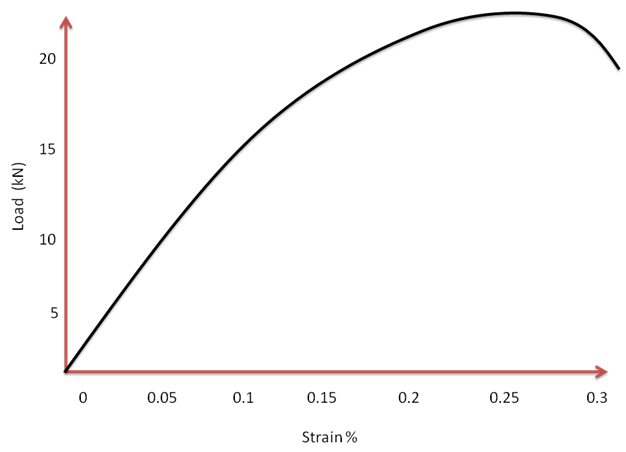
|
a. 28 MPa |
||
|
b. 280 MPa |
||
|
c. 13000 psi |
||
|
d. 12 psi |
||
|
e. 55 GPa |
The following curve is recorded in a tensile stress test for a rod of length 10 cm and diameter 50 mm. What is the modulus of elasticity of the material?

|
a. 18 GPa |
||
|
b. 250 GPa |
||
|
c. 12 GPa |
||
|
d. 7 GPa |
||
|
e. 1.5 GPa |
The following curve is recorded in a tensile stress test for a rod of length 5 cm and diameter 3 mm. What is the ultimate tensile stress of the material?

|
a. 9 GPa |
||
|
b. 7 GPa |
||
|
c. 12 GPa |
||
|
d. 1 GPa |
||
|
e. 3 GPa |
The following curve is recorded in a tensile stress test for a rod of length 5 cm and diameter 25 mm. What is the modulus of elasticity of the material?

|
a. 243 GPa |
||
|
b. 142 GPa |
||
|
c. 285 GPa |
||
|
d. 12 GPa |
||
|
e. 1.2 TPa |
|
a. 200 MPa |
||
|
b. 100 MPa |
||
|
c. 50 MPa |
||
|
d. 10 MPa |
||
|
e. 1 GPa |
The following curve is recorded in a tensile stress test for a rod of length 5 cm and diameter 1 mm. What is theapproximate yield stress of the material?

|
a. 5 GPa |
||
|
b. 20 GPa |
||
|
c. 100 GPa |
||
|
d. 100 MPa |
||
|
e. 2 MPa |
Which of the following expressions best describes the rule of mixtures for the modulus of elasticity of a fiber reinforced composite with volume fractions Vfiber and Vmedium and Young's moduli Efiber and Emedium for stress in the fiber direction?
|
a. Ecomposite + Vfiber Efiber + Vmedium Emedium |
||
|
b. Ecomposite + Vfiber/ Efiber + Vmedium / Emedium |
||
|
c. 1/Ecomposite + Vfiber Efiber + Vmedium Emedium |
||
|
d. 1/Ecomposite + Vfiber /Efiber + Vmedium /Emedium |
||
|
e. Ecomposite = Efiber + Emedium |
Which of the following statements best describes the rule of mixtures for the modulus of elasticity of a fiber reinforced composite for stress transverse to the fiber direction? The volume fractions and moduli of the individual phases are Vfiber and Vmedium and Efiber and Emedium.
|
a. 1/E composite = Vfiber /Efiber + V medium /Emedium |
||
|
b. 1/E composite = Vfiber Efiber + V medium Emedium |
||
|
c. E composite = Vfiber /Efiber + V medium Emedium |
||
|
d. 1/E composite = Vfiber Efiber + V medium Emedium |
||
|
e. 1/E composite = Vfiber Efiber + V medium /Emedium |
What is meant by the phrase composite material in engineering mechanics?
|
a. A material that is improperly mixed |
||
|
b. A material consisting of two or more phases or materials at a molecular level |
||
|
c. A material that deforms in stages when exposed to stress |
||
|
d. A material that fractures unevenly when exposed to stress |
||
|
e. A material that is glued together from plates or fibers |
What would the rule of mixtures predict for the transverse modulus of elasticity for a 60-40% by volume mixture of fiber (E = 120 GPa) and polymer (E = 15 GPa), respectively?
|
a. 32 GPa |
||
|
b. 16 GPa |
||
|
c. 8 GPa |
||
|
d. 68 GPa |
||
|
e. 115 GPa |
What would the rule of mixtures predict for the parallel modulus of elasticity for a 60-40% by volume mixture of fiber (E = 120 GPa) and polymer (E = 15 GPa)?
|
a. 38 GPa |
||
|
b. 15 GPa |
||
|
c. 12 GPa |
||
|
d. 55 GPa |
||
|
e. 78 GPa |
Which of the following statements best describes the rule of mixtures as predictive for the behavior of fiber/polymer composite media?
|
a. It is a good rule to keep in mind, but it may be unreliable for many materials. |
||
|
b. It is a well established rule that is applicable to a wide range of materials. |
||
|
c. It is a universal law that is applicable to all composites. |
||
|
d. It describes behaviors in the limits of small volume fractions of one phase or the other. |
||
|
e. It is an idealization that has not proven useful. |
How do engineering stress and engineering strain differ from actual stress and actual strain in a stress-strain curve measurement?
|
a. Engineering stresses and strains are always reported in metric units. |
||
|
b. Engineering stresses and strains are calculated in terms of the undeformed or original cross-sectional area, but the acutal stresses and strains are calculated from the simultaneous areas. |
||
|
c. Engineering stresses and strains are calculated in terms of the simultaneous cross-sectional areas, but the acutal stresses and strains are calculated in terms of the original or undeformed areas. |
||
|
d. Engineering measures are always reported in powers of 1000. Actual stresses and strains may be reported in any system. |
||
|
e. Actual stresses and strains take into account thermal expansion; engineering calculations do not. |
How do brittle materials differ from ductile materials?
|
a. Brittle materials fail more suddenly under stress; ductile materials yield before fracture. |
||
|
b. Ductile materials fail more suddenly under stress; brittle materials yield before fracture. |
||
|
c. Ductile materials have a lower yield stress than brittle materials. |
||
|
d. Brittle materials have a higher ultimate tensile strength than ductile materials. |
||
|
e. Brittle materials have a lower modulus of elasticity than ductile materials. |
Which of the following statements best describes the differences between elastic and plastic deformation?
|
a. Plastic deformation stores energy; elastic deformation dissipates energy. |
||
|
b. Elastic deformation occurs in metals; plastic deformation occurs in polymers. |
||
|
c. Elasitc deformation occurs at higher temperatures than plastic deformation. |
||
|
d. Elastic deformation automatically reverses upon removal of the stress; plastic deformation does not. |
||
|
e. Elastic deformation is not as reproducible as plastic deformation. |
Which of the following statements best describes the differences between necking and drawing of mechanical specimens?
|
a. They are synonymous. |
||
|
b. Necking refers to the strain hardening upon deformation; drawing refers to reduction in neck diameter. |
||
|
c. Drawing refers to the strain hardening upon deformation; necking refers to reduction in neck diameter. |
||
|
d. Necking refers to the reduction in cross sectional area under tension; drawing refers to the introduction of new material into a necked region. |
||
|
e. Drawing refers to the reduction in cross-sectional area under tension; necking refers to the introduction of new material into a drawn region. |
Estimate the strain hardening parameter for the material exhibitingthe stress-strain relationship in the figure below?
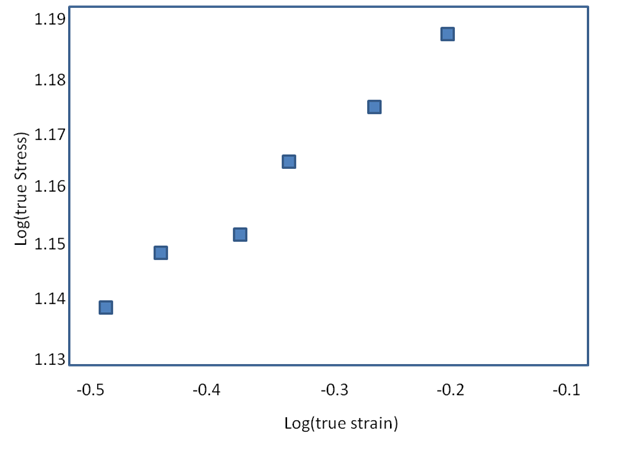
|
a. 0.17 |
||
|
b. 0.57 |
||
|
c. 0.71 |
||
|
d. Undefined |
||
|
e. 6.03 |
Estimate the strain hardening parameter for the material exhibitingthe stress-strain relationship in the figure below?
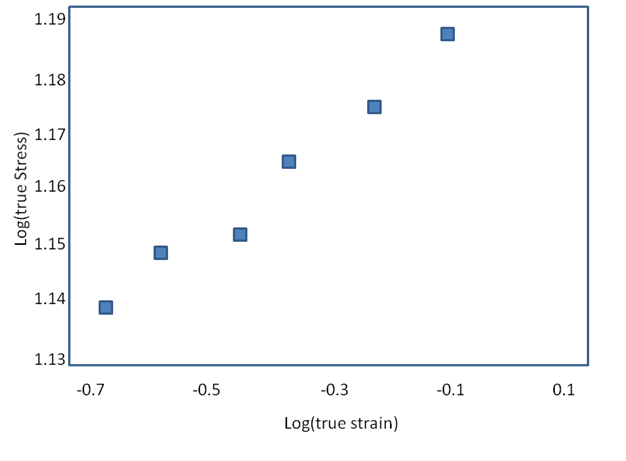
|
a. 0.03 |
||
|
b. 0.08 |
||
|
c. 0.005 |
||
|
d. 0.17 |
||
|
e. 0.32 |
For a material with a Young’s modulus of 57 GPa, estimate the stored strain energy per unit volume for a linear elastic strain of 1%.
|
a. 28 GPa |
||
|
b. 57 GPa |
||
|
c. 2.8 kPa |
||
|
d. 2.8 MPa |
||
|
e. 5.7 MPa |
For a material with a Young’s modulus of 112 GPa, estimate the stored strain energy per unit volume for a linear elastic strain of 0.05%.
|
a. 28 GPa |
||
|
b. 14 GPa |
||
|
c. 2.8 kPa |
||
|
d. 2.8 MPa |
||
|
e. 1.4 MPa |
Which of the following are appropriate units for energy per unit area?
|
a. Pa m |
||
|
b. N m |
||
|
c. psi |
||
|
d. dynes |
||
|
e. lbf/s |
Which of the following is true for statically indeterminate trusses?
I. They are inherently unstable.
II. They deflect more than statically determinate trusses.
III. Consideration of deflection is necessary to solve for all internal forces.
IV. They require welded joints rather than pin-connected joints.
|
a. II and IV only |
||
|
b. IV only |
||
|
c. II and III only |
||
|
d. III and IV |
||
|
e. III only |
A spherical pressure vessel is made of a material with an ultimate tensile strength of about 200 MPa. What pressure can a vessel that is 50 cm in diameter and 0.5 cm in wall thickness withstand?
|
a. 8 x 10 9 Pa |
||
|
b. 125 atm |
||
|
c. 78 atm |
||
|
d. 14.7 psi |
||
|
e. 8 x 10 4 Pa |
A spherical pressure vessel is made of a material with a yield strength of about 200 MPa. What pressure can a vessel that is 25 cm in diameter and 0.4 cm in wall thickness withstand?
|
a. 13 x 10 6 Pa |
||
|
b. 12 atm |
||
|
c. 1300 atm |
||
|
d. 14.7 atm |
||
|
e. 101325 Pa |
|
a. 7 |
||
|
b. 0.08 |
||
|
c. 1.5 |
||
|
d. 0.0008 |
||
|
e. 0.04 |
A 10 inch inner diameter pipe with wall thickness 0.25 inches is pressurized to 1500 psi. What is the percentage expansion in the pipe diameter upon pressurization if the Young’s modulus of the pipe material is 250 GPa?
|
a. 0.08 |
||
|
b. 0.8 |
||
|
c. 0.04 |
||
|
d. 0.004 |
||
|
e. 0.4 |
How do shear stresses and normal stresses differ?
|
a. They have different units. |
||
|
b. Shear stresses act to slide parallel planes of material apart without changing separation, whereas normal stresses act to increase or decrease the separation between parallel planes of material. |
||
|
c. Shear stresses are the absolute stresses, whereas normal stresses have been divided by the total stress. |
||
|
d. Normal stresses act at the surfaces of materials, whereas shear stresses act within materials. |
||
|
e. Normal stresses act within materials, whereas shear stresses act at the surfaces of materials. |
Asolid shaft of diameter 2 inches, shear modulus of 75 GPa, and length 1 m is subject to a torque of 5 kNm. What is the angular strain of the shaft?
|
a. 32 degrees |
||
|
b. 1.6 radians |
||
|
c. 5.8 degrees |
||
|
d. 1.6 degrees |
||
|
e. 0.004 radians |
Asolid shaft of diameter 2 inches, shear modulus of 50 GPa, and length 0.5 m is subject to a torque of 5 kNm. What is the angular strain of the shaft?
|
a. 0.5 radians |
||
|
b. 0.44 degrees |
||
|
c. 0.88 degrees |
||
|
d. 0.09 degrees |
||
|
e. 4.4 degrees |
Drive shafts are often constructed from thin walled cylinders. Consider such a cylinder of length 0.75 m, outer diameter 3 inches, and wall thickness 0.25 inches. The material has a shear modulus of 68 GPa. What is the angular strain for an applied torque of 750 Nm?
|
a. 0.27 degrees |
||
|
b. 0.36 radians |
||
|
c. 0.32 degrees |
||
|
d. 4 radians |
||
|
e. 0.18 degrees |
Drive shafts are often constructed from thin walled cylinders. Consider such a cylinder of length 0.75 m, outer diameter 3 inches, and wall thickness 0.25 inches. The material has a shear modulus of 68 GPa. What is the angular strain for an applied torque of 1750 Nm?
|
a. 0.64 degrees |
||
|
b. 0.34 radians |
||
|
c. 2.1 degrees |
||
|
d. 8 radians |
||
|
e. 0.006 degrees |
In which of the following geometries is stress concentration most pronounced?
|
a. In the center of a large beam under transverse load |
||
|
b. At the middle of a column under a parallel load |
||
|
c. Near the corners of a triangular window in a pressure vessel |
||
|
d. On the edge of a spherical pressure vessel |
||
|
e. At the apex of a free standing column |
Calculate the volumetric or dilatational strain for a cube subject to normal strains of ex= 0.001, ey = 0.003, and ez = 0.0007, and a shear strain txy of 0.0048.
|
a. 0.0052 |
||
|
b. 0.0035 |
||
|
c. 0.001 |
||
|
d. 0.01 |
||
|
e. 0.0047 |
Calculate the volumetric or dilatational strain for a cube subject to normal strains of ex= 0.001, ey = 0.02, and ez = 0.0009, and a shear strain tyz of 0.0077.
|
a. 0.077 |
||
|
b. 0.097 |
||
|
c. 0.0219 |
||
|
d. 0.0438 |
||
|
e. 0.015 |
|
a. A normal stress is a force per area of unit magnitude; a traction vector is not normalized. |
||
|
b. A traction vector is a shearing force per unit area; a normal stress is a force orthogonal to the area on which it is acting. |
||
|
c. A traction vector is a force per area of arbitrary direction; a normal stress is orthogonal to the area on which it is acting. |
||
|
d. A normal stress is a force per area of arbitrary direction; a traction vector is orthogonal to the area on which it is acting. |
||
|
e. Normal stresses and traction vectors act in opposite directions. |
|
a. Pa m |
||
|
b. Pa s |
||
|
c. N m |
||
|
d. psi |
||
|
e. N |
|
a. The order of a tensor describes the dimensionality of an array; a first order tensor is like a vector; a second order tensor is like a two-dimensional array. |
||
|
b. The order of a tensor describes the dimensionality of an array; a zeroth order tensor is like a vector; a first order tensor is like a two-dimensional array. |
||
|
c. The order of a tensor describes the dimensionality of the elements; a first order tensor contains only primary quantities; a second order tensor contains quadratic quantities. |
||
|
d. The order of a tensor describes the order of elements; a first order tensor has elements in increasing order; a second order tensor has the largest elements near the center. |
||
|
e. The order of a tensor describes the geometry from which it is derived; a first order tensor is applicable to two dimensional (planar) mechanics; second order tensors are required for three-dimensional mechanics. |
Which of the following best describes the utility of Mohr’s circle?
|
a. It is a measure of hardness of materials. |
||
|
b. It provides a way of visualizing and remembering how tensors rotate. |
||
|
c. It allows for the convenient computation of torque from applied forces. |
||
|
d. It is a conventient accounting tool for tallying applied torques. |
||
|
e. It is a method of computing resultant forces. |
|
a. Equilibrium relationships describe materials chemistry; kinematic relationships describe velocities as a function of time; constitutive relationships describe compliance with codes for material behavior. |
||
|
b. Constitutive relations describe tensor rotations; equilibrium relationships describe bending forces; kinematic relationships describe trajectories. |
||
|
c. Equilibrium relations describe static objects; kinematic relations describe moving objects; constitutive relations describe material composition. |
||
|
d. Equilibrium relations consider the action of external forces or tractions; kinematic relations consider the geometry of deformation; constitutive relations characterize a the response of a material to deformation. |
||
|
e. Constitutive relations characterize the temperature and pressure dependence of density and shear modulus; equilibrium relations are overall force balances; kinematic relations describe the velocities of individual particles at the object surfaces. |
The stress tensor in a plane contains the following elements sigmax = 4 psi, sigmay = 6 psi, and tauxy = 2.3 psi. In a new coordinate system x’y’ rotated 15 degrees counter clockwise from the original coordinate system, what is taux’y'?
|
a. 1.2 psi |
||
|
b. 2.3 psi |
||
|
c. 6.0 psi |
||
|
d. 2.5 psi |
||
|
e. 0.3 psi |
|
a. 2.8 psi |
||
|
b. 4.3 psi |
||
|
c. 6.2 psi |
||
|
d. 2.0 psi |
||
|
e. 1.0 psi |
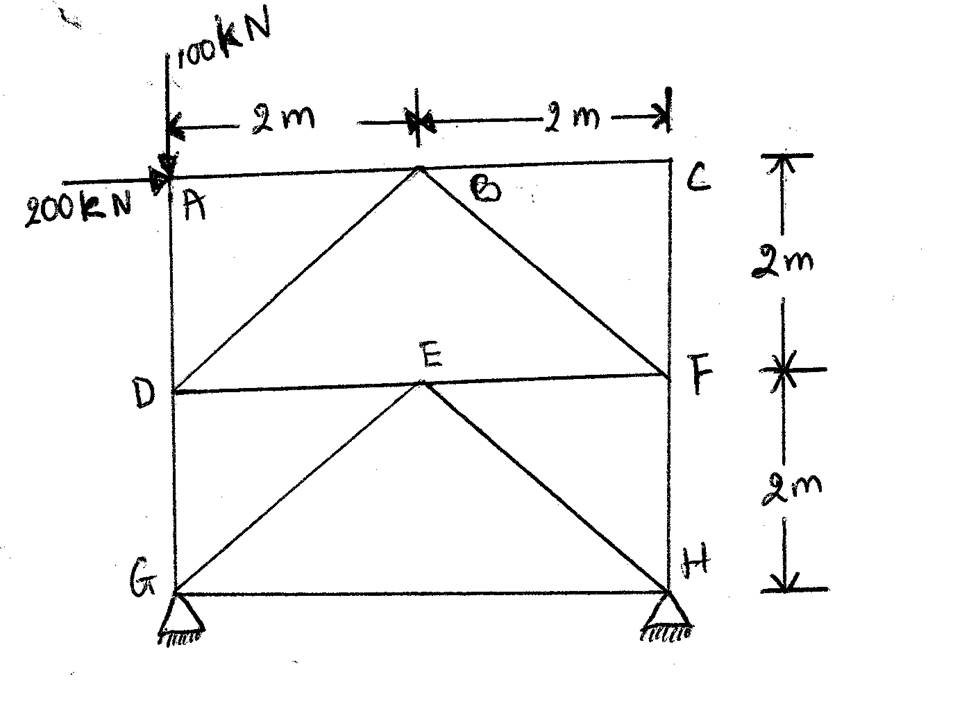
|
a. -150 kN |
||
|
b. 200 kN |
||
|
c. -200 kN |
||
|
d. 100 kN |
||
|
e. -100 kN |

|
a. -150 kN |
||
|
b. 200 kN |
||
|
c. -200 kN |
||
|
d. -100 kN |
||
|
e. -50 kN |

|
a. 0 kN |
||
|
b. 50 kN |
||
|
c. 144 kN |
||
|
d. -50 kN |
||
|
e. -144 kN |

|
a. 0 kN |
||
|
b. 50 kN |
||
|
c. 144 kN |
||
|
d. -50 kN |
||
|
e. -100 kN |

|
a. 0 kN |
||
|
b. 50 kN |
||
|
c. 144 kN |
||
|
d. -50 kN |
||
|
e. -100 kN |

|
a. -144 kN |
||
|
b. 50 kN |
||
|
c. 144 kN |
||
|
d. -50 kN |
||
|
e. 100 kN |

|
a. -144 kN |
||
|
b. 50 kN |
||
|
c. 144 kN |
||
|
d. -50 kN |
||
|
e. -100 kN |
|
a. 16 |
||
|
b. 8 |
||
|
c. 12 |
||
|
d. 13 |
||
|
e. 6 |
|
a. 1.5 kg m 2 |
||
|
b. 1 kg m 2 |
||
|
c. 1.25 kg m 2 |
||
|
d. 2.0 kg m 2 |
||
|
e. 3.0 kg m 2 |
|
a. 2.25 kg m2 |
||
|
b. 3 kg m2 |
||
|
c. 2 kg m2 |
||
|
d. 1.25 kg m2 |
||
|
e. 0.75 kg m2 |
|
a. 4 |
||
|
b. 3 |
||
|
c. 2 |
||
|
d. 1 |
||
|
e. 9 |
|
a. The number of reactions is unknown. |
||
|
b. The number of reactions is greater than the number of equilibrium equations. |
||
|
c. The number of reactions is equal to the number of equilibrium relations. |
||
|
d. The number of reactions is less than the number of equilbirium relations. |
||
|
e. The number of reactions is equal to the number of equilibrium relations minus 2. |
|
a. 100 kN |
||
|
b. 75 kN |
||
|
c. 50 kN |
||
|
d. 200 kN |
||
|
e. 25 kN |
|
a. 6.6 GPa |
||
|
b. 42 GPa |
||
|
c. 0.42 GPa |
||
|
d. 66 MPa |
||
|
e. 33 MPa |
|
a. 25 kN |
||
|
b. 15 kN |
||
|
c. 11 kN |
||
|
d. 9kN |
||
|
e. 90 kN |
|
a. 1 cm |
||
|
b. 3 cm |
||
|
c. 7 cm |
||
|
d. 12 cm |
||
|
e. 120 cm |
|
a. Increases by 6 fold |
||
|
b. Increases by 9 fold |
||
|
c. Increases by 3 fold |
||
|
d. Increases by 81 fold |
||
|
e. Increases by 27 fold |
|
a. EI d 4/dx4 = q(x) |
||
|
b. EI d 2/dx2 = q(x) |
||
|
c. EI d/dx = q(x) |
||
|
d. EIx d 3/dx3 = q(x) |
||
|
e. EI d 3/dx3 = q(x) |
|
a. A constant coefficient second order differential equation |
||
|
b. A first order differential equation |
||
|
c. A fifth order differential equation |
||
|
d. A fourth order differential equation |
||
|
e. A second order differential equation |
To whom is the development of beam theory commonly attributed?
I. Bernoulli
II. Gauss
III. Tesla
IV. Liebnitz
V. Franklin
VI. Euler|
a. I and VI |
||
|
b. I, II, III, IV, and VI |
||
|
c. I, II, and VI |
||
|
d. V |
||
|
e. IV and I |
A horizontal beam simply supported at either end and loaded in the middle will exhibit which of the following?
|
a. Compression in the upper portion of the beam and tension in the lower portion |
||
|
b. Compression in the upper portion of the beam and compression in the lower portion |
||
|
c. Tension in the upper portion of the beam and compression in the lower portion |
||
|
d. Compression in the upper portion of the beam and tension in the lower portion |
||
|
e. Deflection or bending without tension or compression |
How does a cantilever support differ from a simple beam support?
|
a. They do not differ. |
||
|
b. A cantilever support can provide both support force and moment, whereas a simple support can only force at a point. |
||
|
c. A simple support can provide both support force and moment, whereas a cantilever support can only force at a point. |
||
|
d. A cantilever support can only provide transverse support, whereas a simple support can provide both vertical and horizontal support. |
||
|
e. A cantilever support can provide only vertical support, whereas a simple support can only provide transverse support. |
Which of the following would be the most appropriate description of the beam configuration shown in the figure below?
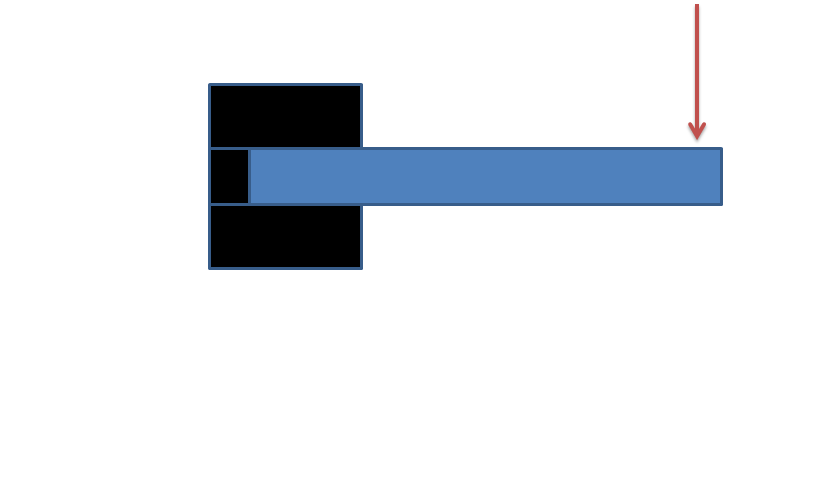
|
a. End loaded, cantilevered beam |
||
|
b. Simply supported, end loaded beam |
||
|
c. Simply supported, cantilevered beam |
||
|
d. Center loaded, cantilevered beam |
||
|
e. Center loaded, simply supported beam |
Which of the following would be the most appropriate description of the beam configuration shown in the figure below?
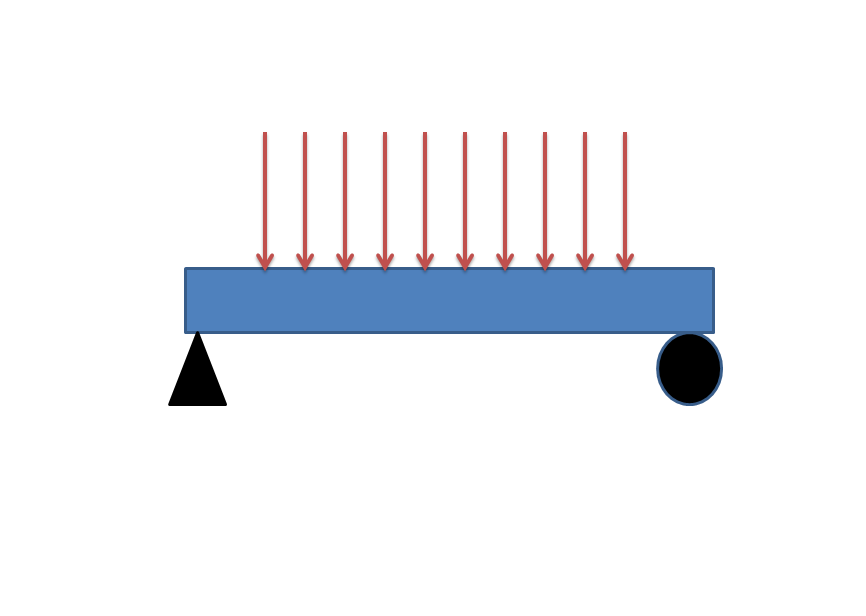
|
a. End loaded, cantilevered beam |
||
|
b. Simply supported beam with a distributed load |
||
|
c. Simply supported, cantilevered beam |
||
|
d. Center loaded, cantilevered beam |
||
|
e. Center loaded, simply supported beam |
Which of the following would be the most appropriate description of the beam configuration shown in the figure below?
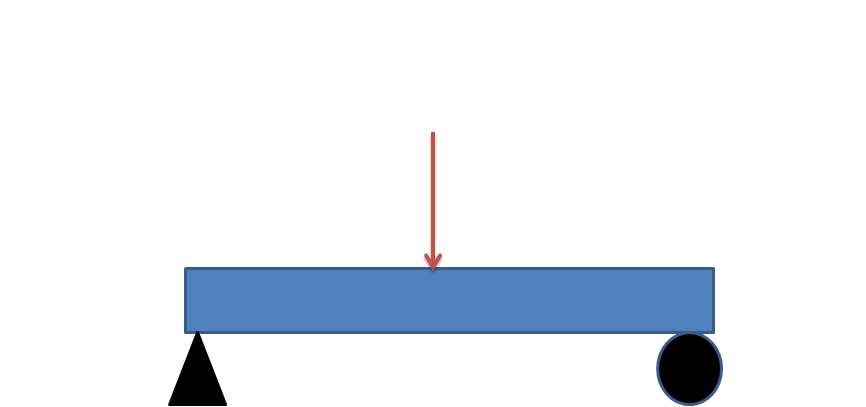
|
a. End loaded, cantilevered beam |
||
|
b. Simply supported beam with a distributed load |
||
|
c. Simply supported, cantilevered beam |
||
|
d. Center loaded, cantilevered beam |
||
|
e. Center loaded, simply supported beam |
A loaded crane hook is shown in the schematic below. A long which plane is the hook likely to have the largest stress?
I. AB
II. CB
III. DE
IV. EF
V. FG
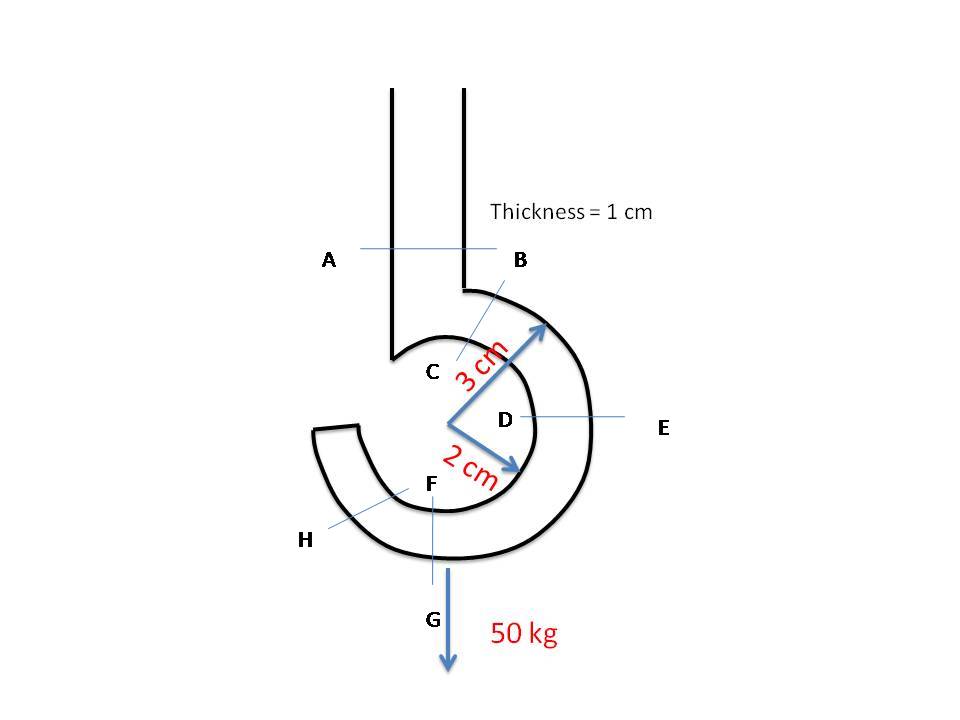
|
a. I |
||
|
b. II |
||
|
c. III |
||
|
d. IV |
||
|
e. V |
Consider the following matrix notation equation.
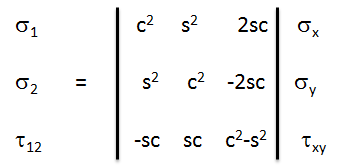
What is the correct expression for tau12?
|
a. τ12 = -sc σx + scσy + (c2-s2 ) τxy |
||
|
b. τ12 = -sc σx + scσy + 2sc τxy |
||
|
c. τ12 = -sc σx + scσx + (c2-s2 ) τxy |
||
|
d. τ12 = -sc σx + scσy + (-2sc) τxy |
||
|
e. τ12 = -sc σx + scσy + (c2-s2 ) σx |
Consider the following matrix notation equation.

What does the term c2-s2 refer to?
|
a. cos2 θ - sin2 θ where θ is the angle between coordinate systems |
||
|
b. cos θ2 - sin θ2 where θ is the angle between coordinate systems |
||
|
c. cos θ2 - sin θ2 where θ is the angle between principal axes |
||
|
d. cos2 θ - sin2 θ where θ is the angle between fibers |
||
|
e. cos θ2 - sin2 θ where θ is the angle between coordinate systems |
Which of the following is the best description of an orthotropic material?
|
a. Orthotropic materials have material properties which are the same in all directions. |
||
|
b. Orthotropic materials have properties which are different along each orthogonal axis. |
||
|
c. An orthotropic material has a steep temperature dependence of material properties. |
||
|
d. An orthotropic material has material properties that are the same in at least two orthogonal directions. |
||
|
e. An orthotropic material has material properties that are independent of temperature. |
Which of the following are examples of anisotropic materials?
I. Wood
II. Steel
III. Water
IV. Aluminum
|
a. III |
||
|
b. II and III |
||
|
c. I |
||
|
d. II and IV |
||
|
e. I and III |
Consider the following matrix notation equation.
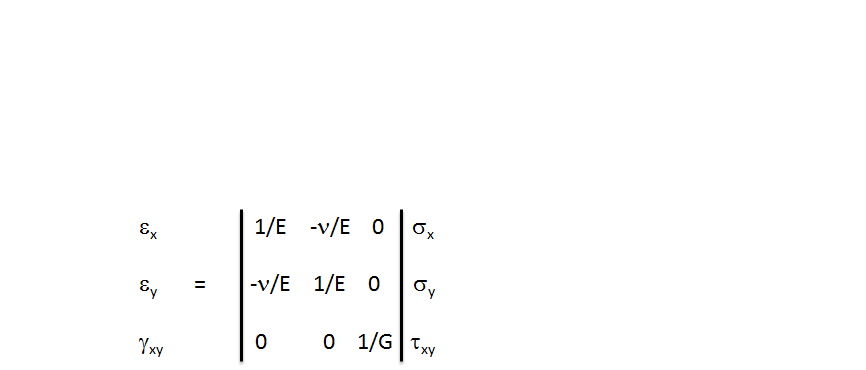
Which of the following is the equation for the normal strain in the y direction?
|
a. εy = -ν/E σx + 1/E σy |
||
|
b. εy = -ν/E σx + 1/G σy |
||
|
c. εy = -ν/E σx + 1/E γxy |
||
|
d. εy = -ν/E σy + 1/E σy |
||
|
e. εy = -ν/E σy + 1/E σx |
Consider the following matrix notation equation.

Which of the following is the equation for the shear strain?
|
a. γxy = -ν/E σx + 1/E σy |
||
|
b. γxy = -ν/E σx + 1/G σy |
||
|
c. γxy = -ν/E σx + 1/E γxy |
||
|
d. γxy = -ν/E σy + 1/E σy |
||
|
e. γxy = 1/G τxy |
|
a. Display of light fringes that change when light passes through gradients of changing orientation or spacing |
||
|
b. Display of diffraction gratings that change with strain |
||
|
c. Display of optical birefringence patterns that change with strain |
||
|
d. Display of laser induced grid displacement upon strain |
||
|
e. Display of grid rotation and alignment upon strain |
|
a. Cube |
||
|
b. Rhombus |
||
|
c. Sphere |
||
|
d. Circle |
||
|
e. Ellipse |
|
a. Just above and below the hole |
||
|
b. At both lateral edges of the hole |
||
|
c. Far from the hole in the bulk of the material |
||
|
d. At the top edge of the hole |
||
|
e. Near the entire edge of the hole |
|
a. All measures of strain are not independent of one another. |
||
|
b. There is no slip at boundaries between different materials. |
||
|
c. Strain releases energy. |
||
|
d. Strains of two touching materials may be different. |
||
|
e. Thermal expansion of different materials may cause defects at boundaries. |
Which of the following properties are exploited to use photoelasticity to monitor strain?
|
a. Refractive index |
||
|
b. Birefringence |
||
|
c. Absorbance |
||
|
d. Temperature-dependent refraction |
||
|
e. Reflection |
In which of the following ways do common electrical strain gauges work?
|
a. Changes in inductance upon strain |
||
|
b. Changes in radio-frequency penetration upon strain |
||
|
c. Changes in electrical resistance upon strain |
||
|
d. Creation of short circuits upon strain |
||
|
e. Changes in dielectric constant upon strain |
Which of the following best describes the finite element method?
|
a. Description of mechanical materials in terms of a finite number of chemical elements |
||
|
b. Description of mechanical behavior in terms of a finite number of motions |
||
|
c. Method for reducing the mathematical complexity of problems by writing them in terms of a finite number of algebraic relations |
||
|
d. Method of approximating mechanical behavior by including only the most important truss elements |
||
|
e. Representation of material behavior by a finite number of mechanical rods and springs |
In wire drawing, the drawing stress can often be represented by σ = σY ln(A0/A), where A0 and A are the initial and final areas of the wire. If we constrain σ/σY to be 0.9, then what is the percentage reduction (100*(1-d/d0)) in wire diameter that can be achieved in a single drawing operation?
|
a. 24% |
||
|
b. 12% |
||
|
c. 36% |
||
|
d. 48% |
||
|
e. 56% |
In wire drawing, the drawing stress can often be represented by σ = σY ln(A0/A), where A0 and A are the initial and final areas of the wire. If we constrain σ/σY to be 0.7, then what is the percentage reduction (100*(1-d/d0)) in wire diameter that can be achieved in a single drawing operation?
|
a. 30% |
||
|
b. 20% |
||
|
c. 10% |
||
|
d. 5% |
||
|
e. 15% |
How do yield and fracture processes generally vary with temperature?
|
a. Fracture becomes more likely at lower temperatures, and yield becomes more likely at higher temperatures. |
||
|
b. Both yield and fracture become more likely at higher temperatures. |
||
|
c. Both yield and fracture become more likely at lower temperatures. |
||
|
d. Yield becomes more likely at lower temperatures, and fracture becomes more likely at higher temperatures. |
||
|
e. Both responses have unpredictable variations with temperature. |
The stress tensor in a test configuration is given (in MPa) by
1024
2123
438
Compute the Von Mises stress according to
σM =sqrt( ½ [(σx − σy)2+ (σx − σz)2+ (σy − σz)2+ 6(τxy + τyz + τxz)]).
|
a. 3 MPa |
||
|
b. 6 MPa |
||
|
c. 1 MPa |
||
|
d. 8 MPa |
||
|
e. 12 MPa |
The stress tensor in a test configuration is given (in MPa) by
1224
263
438
Compute the Von Mises stress according to
σM =sqrt( ½ [(σx − σy)2+ (σx − σz)2+ (σy − σz)2+ 6(τxy + τyz + τxz)]).
|
a. 3.2 MPa |
||
|
b. 6.2 MPa |
||
|
c. 9.3 MPa |
||
|
d. 7.4 MPa |
||
|
e. 7.0 MPa |
|
a. They are equal. |
||
|
b. The von Mises stress is twice the Tresca stress. |
||
|
c. The von Mises stress is four times the Tresca stress. |
||
|
d. The von Mises stress is square root (2) times the Tresca stress. |
||
|
e. The von Mises stress is half the Tresca stress. |
What is the maximum shear stress occurring in a cylindrical pressure vessel of length 1m, diameter 0.3 m, and wall thickness 1 cm when pressurized to12 atm?
|
a. 3 MPa |
||
|
b. 1 MPa |
||
|
c. 6 MPa |
||
|
d. 9 MPa |
||
|
e. 12 MPa |
What is the maximum shear stress occurring in a cylindrical pressure vessel of length 1m, diameter 0.3 m, and wall thickness 1 cm when pressurized to 100 psi?
|
a. 1 MPa |
||
|
b. 5 MPa |
||
|
c. 10 MPa |
||
|
d. 15 MPa |
||
|
e. 25 MPa |
In a tensile test, a material is found to yield at a normal stress of 82 MPa. What is the Tresca critical shear stress for yield for that material?
|
a. 20 Mpa |
||
|
b. 11 Mpa |
||
|
c. 12 Mpa |
||
|
d. 41 MPa |
||
|
e. 82 MPa |
What value of Poisson’s ratio characterizes deformation without change in volume?
|
a. -0.5 |
||
|
b. 0.0 |
||
|
c. 0.33 |
||
|
d. 0.5 |
||
|
e. 1.0 |
How do the processes leading to fracture differ from those causing yield?
|
a. Yield depends more upon shear stresses, and fracture depends more upon normal stresses. |
||
|
b. Fracture depends more upon shear stresses, and yield depends more upon normal stresses. |
||
|
c. Yield results from steady stress, and fracture results from time-varying stress. |
||
|
d. Both phenomena result from the same forces. |
||
|
e. Fracture results from steady stress, and yield results from time-varying stress. |
How does plastic flow differ from elastic deformation?
|
a. Elastic deformation is instantaneous upon loading and reversible upon removal of load; plastic deformation may be slow and persists after removal of the load. |
||
|
b. The phenomena are very similar. |
||
|
c. Plastic flow releases more heat than elastic deformation. |
||
|
d. Plastic flow is reversible upon removal of the load; elastic deformation is not. |
||
|
e. Plastic flow stores the energy of deformation; elastic deformation does not. |
Which of the following best defines fracture as used in the study of the strength of materials?
|
a. The process of a piece of material separating into two or more pieces |
||
|
b. The growth of defects |
||
|
c. The process of the creation of many small fragments from one large piece |
||
|
d. The process of crack formation during shear flow |
||
|
e. The process of embrittlement at cold temperatures |
In the linear-elastic regime, how does the stress required for fracture scale with the size of the initiating defect?
|
a. Inversely with the square root of the size of the defect |
||
|
b. Inversely with the first power of the size of the defect |
||
|
c. Inversely with the square of the size of the defect |
||
|
d. In proportion to the square root of the size of the defect |
||
|
e. In proportion to the size of the defect |
How does the critical loading force for a long column vary with the Young’s modulus of the column material?
|
a. It is proportional to the Young's modulus of the column. |
||
|
b. It is inversely proportional to the Young's modulus of the column. |
||
|
c. It is proportional to the square root of the Young's modulus of the column. |
||
|
d. It is inversely proportional to the square root of the Young's modulus of the column. |
||
|
e. It does not depend upon the Young's modulus of the column. |
How does the critical loading force for a long column vary with the length of the column?
|
a. It varies inversely as the square of the length of the column. |
||
|
b. It varies in proportion to the column length. |
||
|
c. It varies inversely with the first power of the column length. |
||
|
d. It varies inversely with the square root of the column length. |
||
|
e. It varies inversely with the fourth power of the column length. |
How does the critical loading force for a long column vary with the diameter of the column?
|
a. It increases linearly with diameter. |
||
|
b. It increases as the square of the diameter. |
||
|
c. It increases with the fourth power of the diameter. |
||
|
d. It increases in proportion to the square root of the column diameter. |
||
|
e. It is independent of column diameter. |
How does column buckling differ from column fracture?
|
a. Fracture entails vertical cracks; buckling entails horizontal failure. |
||
|
b. Column buckling and column fracture are the same. |
||
|
c. Column buckling is the bending of a column under load; fracture is column breakup. |
||
|
d. Column fracture is bending under load; buckling is complete collapse. |
||
|
e. Buckling occurs when the footing of a column collapses; fracture occurs when the column itself breaks up. |
|
a. It increases exponentially with increasing temperature. |
||
|
b. It increases linearly with increasing temperature. |
||
|
c. It increases with the fourth power of temperature. |
||
|
d. It increases with the reciprocal of temperature. |
||
|
e. It increases with the square root of temperature. |
Which of the following best describes behavior during primary creep?
|
a. Primary creep exhibits a constant strain rate. |
||
|
b. Primary creep exhibits a decreasing strain rate. |
||
|
c. Primary creep exhibits an increasing strain rate. |
||
|
d. Primary creep is an incubation period in which little strain occurs. |
||
|
e. Primary creep exhibits an exponentially increasing strain rate with time. |
Which of the following statements best describes behavior during tertiary creep?
|
a. Tertiary creep exhibits a constant strain rate. |
||
|
b. Tertiary creep exhibits a decreasing strain rate. |
||
|
c. Tertiary creep exhibits an increasing strain rate followed by material failure. |
||
|
d. Tertiary creep is an incubation period in which little strain occurs. |
||
|
e. Tertiary creep exhibits an exponentially increasing strain rate with time. |
Which of the following best describes behavior during secondary creep?
|
a. Secondary creep exhibits a constant strain rate. |
||
|
b. Secondary creep exhibits a decreasing strain rate. |
||
|
c. Secondary creep exhibits an increasing strain rate followed by material failure. |
||
|
d. Secondary creep is an incubation period in which little strain occurs. |
||
|
e. Secondary creep exhibits an exponentially increasing strain rate with time. |
The vapor pressure of a material is 2 torr at 1289 degrees Kelvin. The melting temperature of the material is 3098 degrees Kelvin. The boiling point of that material is 12032 degrees Kelvin. What is the homologous temperature at 1089 degrees Kelvin?
|
a. 0.35 |
||
|
b. 0.84 |
||
|
c. 0.42 |
||
|
d. 0.09 |
||
|
e. 0.26 |
The vapor pressure of a material is 2 torr at 1289 degrees Kelvin. The melting temperature of the material is 3098 degrees Kelvin. The boiling point of that material is 12032 degrees Kelvin. What is the homologous temperature at 1089 degrees Kelvin?
|
a. 0.38 |
||
|
b. 0.84 |
||
|
c. 0.42 |
||
|
d. 0.09 |
||
|
e. 0.26 |
The vapor pressure of a material is 2 torr at 1289 degrees Kelvin. The melting temperature of the material is 3098 degrees Kelvin. The boiling point of that material is 12032 degrees Kelvin. What is the homologous temperature at 1089 degrees Kelvin?
|
a. 0.38 |
||
|
b. 0.84 |
||
|
c. 0.42 |
||
|
d. 0.09 |
||
|
e. 0.26 |
|
a. It is the ratio of material temperature (absolute) to the melting point temperature (absolute). |
||
|
b. It is the ratio of material temperature (degrees centigrade) to the melting point temperature (degrees centigrade). |
||
|
c. It is the ratio of boiling point temperature (absolute) to the melting point temperature (absolute). |
||
|
d. It is the ratio of the boiling point temperature (degrees centigrade) to the melting point temperature (degrees centigrade). |
||
|
e. It is the ratio of the triple point temperature (absolute) to the melting point temperature (absolute). |
|
a. Creep deformation is slow, plastic flow from a constant stress; cyclic fatigue is weakening from repeated or oscillatory loading. |
||
|
b. Cyclic fatigue is slow, plastic flow from a constant stress; creep is weakening from repeated or oscillatory loading. |
||
|
c. Creep only occurs at low temperatures, but cyclic fatigue can occur at all temperatures. |
||
|
d. Creep occurs on time scales of years; cyclic fatigue occurs on time scales of days. |
||
|
e. Cyclic fatigue occurs on time scales of years; creep occurs on time scales of decades. |
What design considerations can reduce or limit the effects of cyclic fatigue?
I. Keeping the material in compression rather than tension
II. Keeping the material in tension rather than compression
III. Alleviating stress by drilling holes in the part at regions of high stress
|
a. I and III |
||
|
b. II and III |
||
|
c. I only |
||
|
d. II only |
||
|
e. III only |
Low-cycle fatigue can often be correlated with a relationship resembling S=kNc.If the strain amplitude S = 0.01 k for a particular piece, and N = 500, then what is c?
|
a. -0.74 |
||
|
b. -0.64 |
||
|
c. -0.68 |
||
|
d. -0.55 |
||
|
e. -0.5 |
Low-cycle fatigue can often be correlated with a relationship resembling S=kNc.If the strain amplitude S = 0.1 k for a particular piece, and c = -0.5, then what is N?
|
a. 10 |
||
|
b. 100 |
||
|
c. 1000 |
||
|
d. 10000 |
||
|
e. 100000 |
|
a. Low-cycle fatigue occurs at higher stresses and fewer repetitions than high-cycle fatigue. |
||
|
b. Low-cycle fatigue occurs at higher stresses and more repetitions than high-cycle fatigue. |
||
|
c. Low-cycle fatigue occurs at lower stresses and more repetitions than high-cycle fatigue. |
||
|
d. Low-cycle fatigue occurs at lower stresses and fewer repetitions than high-cycle fatigue. |
||
|
e. They are identical processes. |
What is the maximum oscillating stress amplitude that can be sustained for the machine part exhibiting the following S-N curve if the part needs to sustain 10000 cycles?
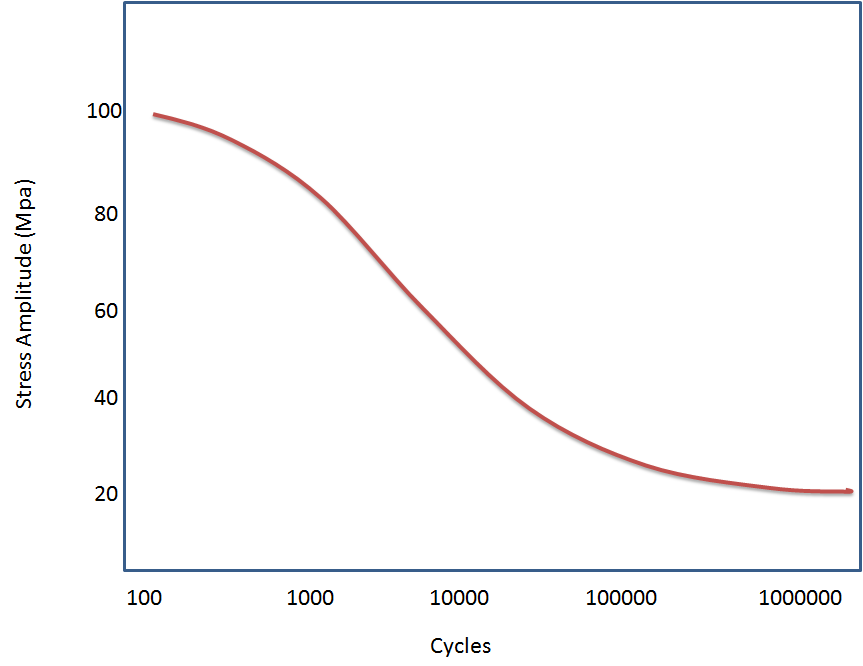
|
a. 20 MPa |
||
|
b. 50 MPa |
||
|
c. 100 MPa |
||
|
d. 100 kPa |
||
|
e. 50 GPa |

|
a. 80000 |
||
|
b. 1000000 |
||
|
c. 100 |
||
|
d. 1000 |
||
|
e. 8000 |

|
a. -0.2 |
||
|
b. 0.2 |
||
|
c. -2 |
||
|
d. 2 |
||
|
e. -1 |
|
a. Distributed loads occur over a range in space; discrete loads occur at specific locations. |
||
|
b. Discrete loads occur over a range in space; distributed loads occur at specific locations. |
||
|
c. There is no real difference. |
||
|
d. Discrete loads may only have values in multiples of 2; distributed loads may have any value. |
||
|
e. Distributed loads are evenly spaced; discrete loads may occur at any location. |
The stress tensor in a test configuration is given (in MPa) by
724
263
438
Compute the Von Mises stress according to
σM =sqrt( ½ [(σx − σy)2+ (σx − σz)2+ (σy − σz)2+ 6(τxy + τyz + τxz)]).
|
a. 3.2 MPa |
||
|
b. 6.2 MPa |
||
|
c. 9.3 MPa |
||
|
d. 7.4 MPa |
||
|
e. 5.5 MPa |
|
a. Truss elements may only support axial loads; beams may support transverse loads. |
||
|
b. They are the same. |
||
|
c. Beams have complex cross sections; truss elements are rods. |
||
|
d. Truss elements buckle under compression; beams do not do so as easily. |
||
|
e. Beams do not support tension; truss elements do. |
In wire drawing, the drawing stress can often be represented by σ = σY ln(A0/A), where A0 and A are the initial and final areas of the wire. If we constrain σ/σY to be 0.4, then what is the percentage reduction (100*(1-d/d0)) in wire diameter that can be achieved in a single drawing operation?
|
a. 30% |
||
|
b. 18% |
||
|
c. 10% |
||
|
d. 5% |
||
|
e. 15% |
|
a. It is constant. |
||
|
b. It decreases linearly from the free end to the supported end. |
||
|
c. It increases linearly from the free end to the supported end. |
||
|
d. It increases quadratically from the free end to the supported end. |
||
|
e. It is zero. |
|
a. It increases linearly from the load end to the cantilevered end. |
||
|
b. It decreases linearly from the load end to the cantilevered end. |
||
|
c. It is constant. |
||
|
d. It increases quadratically from the load end to the cantilevered end. |
||
|
e. It decreases quadratically from the load end to the cantilevered end. |
|
a. It is constant. |
||
|
b. It decreases linearly from the free end to the supported end. |
||
|
c. It decreases linearly from the free end to the supported end. |
||
|
d. It increases quadratically from the free end to the supported end. |
||
|
e. It is zero. |
|
a. It increases linearly from the load end to the cantilevered end. |
||
|
b. It decreases linearly from the load end to the cantilevered end. |
||
|
c. It is constant. |
||
|
d. It increases quadratically from the load end to the cantilevered end. |
||
|
e. It decreases quadratically from the load end to the cantilevered end. |
What is the maximum shear stress occurring in a cylindrical pressure vessel of length 1m, diameter 0.5 m, and wall thickness 2 cm when pressurized to 200 psi?
|
a. 1 MPa |
||
|
b. 5 MPa |
||
|
c. 9 MPa |
||
|
d. 15 MPa |
||
|
e. 25 MPa |
1.Determine the magnitude of the force in AB in the truss illustrated below. The triangles are equilateral.
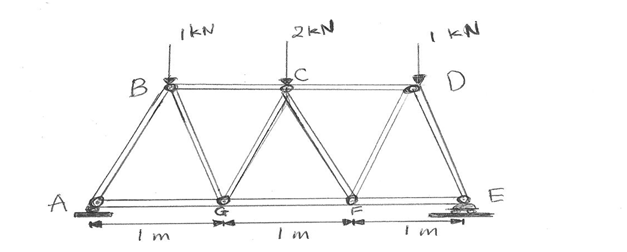
1.Determine the magnitude of the force in AG in the truss illustrated below. The triangles are equilateral.

1.Determine the magnitude of the force in BC in the truss illustrated below. The triangles are equilateral.

1.Determine the magnitude of the force in GF in the truss illustrated below. The triangles are equilateral.

Convert a pressure of 3 atmospheres to units of meters of a fluid of density 0.53 grams/ml (at the earth’s surface). Which of the following best corresponds to that result?
|
a. 67.8 |
||
|
b. 32.4 |
||
|
c. 58 |
||
|
d. 101325 |
||
|
e. 202650 |
Find the angle between the two vectors y = 2 i + 4 j + 8 k and z = 6 i + 4 j + 6 k in degrees. Which of the following best matches the result?
|
a. 55 degrees |
||
|
b. 50 degrees |
||
|
c. 70 degrees |
||
|
d. 28 degrees |
||
|
e. 5 degrees |
|
a. 5 N |
||
|
b. 8.5 N |
||
|
c. 20 N |
||
|
d. 17 N |
||
|
e. 30 N |
|
a. 5 N |
||
|
b. 8.5 N |
||
|
c. 20 N |
||
|
d. 17 N |
||
|
e. 30 N |